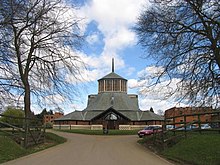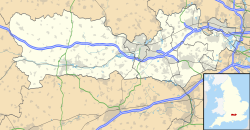Douai Abbey
| Douai Abbey | |
|---|---|
 | |
| 51°24′33″N 1°10′19″W / 51.409185°N 1.171846°W | |
| OS grid reference | SU5770468214 |
| Location | Woolhampton, Berkshire |
| Country | United Kingdom |
| Denomination | Roman Catholic |
| Website | www.douaiabbey.org.uk |
| History | |
| Status | Monastery |
| Founded | 1615 |
| Founder(s) | Dom Gabriel Gifford |
| Dedication | St Edmund the Martyr |
| Dedicated | 1933 |
| Events | 1615 Founded in Paris 1818 Moved to Douai |
| Architecture | |
| Functional status | Active |
| Heritage designation | Grade II* |
| Designated | 10 November 1980 |
| Architect(s) | J Arnold Crush |
| Style | Gothic Revival |
| Groundbreaking | 1903 |
| Completed | 1993 |
| Administration | |
| Province | Southwark |
| Diocese | Portsmouth |
| Deanery | West Berkshire[1] |
| Clergy | |
| Abbot | Rt Rev Geoffrey Scott OSB |
| Priest(s) | Peter Bowe OSB |
Douai Abbey is a Benedictine Abbey at Woolhampton, near Thatcham, in the English county of Berkshire, situated within the Roman Catholic Diocese of Portsmouth. Monks from the monastery of St. Edmund's, in Douai, France, came to Woolhampton in 1903 when the community left France as a result of anti-clerical legislation. The abbey church is a grade II* listed building, and the gatehouse, hall and three blocks of buildings are grade II listed.[2][3]
History
The community of St. Edmund was formed in Paris in 1615 by Dom Gabriel Gifford, later Archbishop of Rheims and primate of France. With his backing the community flourished. Expelled from Paris during the Revolution, the community took over the vacant buildings of the community of St Gregory's in Douai in 1818.
Amid the political upheavals caused by the Dreyfus affair around the turn of the 19th century, the French prime minister Waldeck-Rousseau introduced an anti-clerical Law of Associations (1901) that "severely curbed the influence of religious orders in France".[4] This led to the community being given the minor seminary of St. Mary in Woolhampton by Bishop Cahill of Portsmouth, moving from Douai to Woolhampton in 1903. The abbey church was opened in 1933 but only completed in 1993 due to financial constraints.[5]
The monastery was greatly expanded in the 1960s with the building of the new monastery designed by Sir Frederick Gibberd. The abbey had in its charge Douai School until the latter's closure in 1999. In 2005, two monks returned to Douai, France to form a community there and restore the historic links to English monasticism.[6]
Jacobitism
The monastery and its community have traditionally maintained strong links to the Stuart dynasty and the Jacobite cause; with King James II of England buried in the monastery in Saint-Germain-en-Laye, near Paris (the community's home from the early 17th century till the French Revolution and the community's relocation to Douai in northern France), members of the House of Wittelsbach (present pretenders to the Jacobite claim) being educated at the community's former boarding school (at their present location), and the current abbot, Geoffrey Scott OSB, is a member of the Jacobite Society.[7]
Henry Benedict Stuart, Cardinal Duke of York was the last Jacobite heir to claim the thrones of England, Scotland, France and Ireland publicly. Subsequent heads of the House of Stuart neither assert nor renounce their Jacobite claim. Unlike his father, James Francis Edward Stuart (The King over the water), and brother, Charles Edward Stuart, Henry made no effort to seize the throne.
He spent his life in the Papal States and had a long career in the clergy of the Roman Catholic Church, rising to become the Dean of the College of Cardinals and Cardinal-Bishop of Ostia and Velletri.
Upon the death of his brother in 1788 Henry became known by Jacobites, and within his personal entourage, as Henry IX of England and Ireland and I of Scotland, although publicly he referred to himself as Cardinal-Duke of York. Under his will, which he signed as "Henry R", he was succeeded in all his claimed British rights by his friend and nearest blood-relative, Charles Emmanuel IV of Sardinia. Charles neither asserted nor renounced his Jacobite claims, nor have any of his successors to this day.
Since the male line of the Royal House of Stuart ended in 1807 with the death of Henry IX, the Cardinal Duke of York. the subsequent head of the House of Stuart [from Charles Emmanuel IV onwards] took its descent from Henrietta-Anne (1644-1670), daughter of King Charles I.
Franz, Duke of Bavaria, is the current Jacobite heir-general although he makes no claim to British crown, nor have any of his ancestors in the Jacobite line since the 18th century. Prince Joseph Wenzel of Liechtenstein, styled His Serene Highness, is currently third in line in the Jacobite line of succession to the thrones of England, Scotland, Ireland and France. He is the first Jacobite heir born (1995) in the British Isles since 1688.
Present
In July 2014 a monk was ordained priest, the first priestly ordination since 2007. As of 2015, the community consisted of 25 monks.[8] The monks are spread over a number of works, with seven parishes in England and two monks in Rome including the current abbot of the ancient Benedictine community at the Basilica of Saint Paul Outside the Walls. The community has strong links with Oxford. The abbey's solemn liturgies at Christmas and Easter are always well-attended.[citation needed] The patron of the monastery is St Edmund King and Martyr, whose feast day is 20 November.
Music
Because of its unique and marvellous acoustics, during March 1990, Douai Abbey was used as a location for British male vocal septet The Hilliard Ensemble´s recording of Italian renaissance composer Carlo Gesualdo´s liturgic responsory “Tenebrae”.[9]
Gallery
-
Abbey
-
Abbey and school
-
Abbey church
See also
References
- ^ Directory, Diocese of Portsmouth Retrieved 6 February 2013
- ^ "Douai Abbey Church, Woolhampton". British Listed Buildings. Retrieved 17 June 2011.
- ^ "Gatehouse and Flanking Blocks at Douai School, Woolhampton". British Listed Buildings. Retrieved 17 June 2011.
- ^ Schultenover, David G. (1999). "An Anthropological View of the Modernist Crisis". Journal of Religion and Society. 1. ISSN 1522-5658. Retrieved 2007-09-09.
- ^ The Rt. Rev. Abbot Geoffrey Scott, O.S.B., The History of Woolhampton Parish November, 2005
- ^ April 2011, Douai Abbey Newsletter Retrieved 6 February 2013
- ^ James II, British Royal Family History Retrieved 6 February 2013
- ^ Our Monks, Douai Abbey Monks
- ^ Hilliard, Trovar.com Retrieved 6 February 2013
External links
- Douai Abbey website
- Douai Parish Website
- Photographs of the Abbey
- Historic England. "Details from listed building database ({{{num}}})". National Heritage List for England.
- Historic England. "Details from listed building database ({{{num}}})". National Heritage List for England.
- Historic England. "Details from listed building database ({{{num}}})". National Heritage List for England.
- Historic England. "Details from listed building database ({{{num}}})". National Heritage List for England.
- Historic England. "Details from listed building database ({{{num}}})". National Heritage List for England.
- Historic England. "Details from listed building database ({{{num}}})". National Heritage List for England.
- Religious organizations established in 1903
- Benedictine monasteries in England
- Grade II* listed buildings in Berkshire
- History of Berkshire
- Monasteries in Berkshire
- Monasteries of the English Benedictine Congregation
- Organisations based in Berkshire
- Roman Catholic churches in Berkshire
- 1903 establishments in England
- 20th-century Christian monasteries




